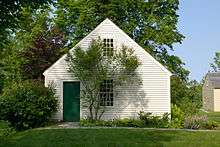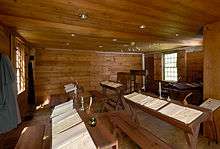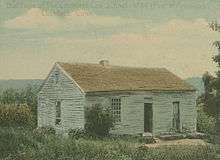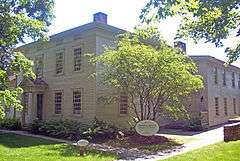Litchfield Law School
|
Tapping Reeve House and Law School | |
|
East elevation and north profile of Tapping Reeve House, 2010 | |
  | |
| Location | Litchfield, CT |
|---|---|
| Coordinates | 41°44′38″N 73°11′19″W / 41.74395°N 73.18851°WCoordinates: 41°44′38″N 73°11′19″W / 41.74395°N 73.18851°W |
| Built | 1773 |
| NRHP Reference # | 66000879 |
| Significant dates | |
| Added to NRHP | October 15, 1966[1] |
| Designated NHL | December 21, 1965[2] |
The Litchfield Law School of Litchfield, Connecticut, was the first proprietary law school founded in the United States of America.[3] The school was founded by Tapping Reeve in 1784 after tutoring students, including his brother-in-law, Aaron Burr, in law in the ten years previously and developing a 14-month course of study to prepare students for the Bar exam. Reeve, who later became the Chief Justice of the Connecticut Supreme Court, hired former student James Gould to assist him in delivering lectures. By the time the school closed in 1833, over 1,100 young men from throughout the country had attended, many of whom went on to have significant influence on political, economic, and legal development of the United States during the antebellum period. Some of the school's most notable students include Burr and John C. Calhoun.[4]
The law school, including Reeve's house, was declared a National Historic Landmark in 1965 as the Tapping Reeve House and Law School.[2][5] The Tapping Reeve House and Law School are owned and operated by the Litchfield Historical Society as a museum and contains the interpretive exhibit The Noblest Study which illustrates the lives and studies of the students who traveled to Litchfield to study at the Litchfield Law School and Litchfield Female Academy.
The Society also operates the Litchfield History Museum.
Tapping Reeve
Tapping Reeve, the founder of the Litchfield Law School, was born in 1744, son of the Rev. Abner Reeve, a Presbyterian minister who had graduated from Yale in 1731, and his wife Deborah. Tapping Reeve attended the College of New Jersey, later Princeton, graduating in 1763. He remained in Elizabethtown to teach at a grammar school associated with the college. Reeve then tutored at Princeton and was hired to privately teach the orphaned children of the Rev. Aaron Burr, Sr., the former President of the college, and his wife Esther Edwards Burr. Tapping Reeve taught young Aaron Burr and his sister Sally for several years. By 1771 Reeve had moved to Hartford, Connecticut, where he studied law with Judge Jesse Root, passing the bar there in 1772.
Reeve moved to Litchfield the same year and established a practice, marrying his former pupil Sally Burr. He built a home on South Street and established a legal practice. In 1774 his brother-in-law, Aaron Burr, left his ministerial studies with the Reverend Joseph Bellamy and moved to Litchfield to study law with Reeve. Burr left a year later to join the Continental Army on the outbreak of the Revolutionary War, but Reeve continued to take law students.
Law School
In the early years Reeve continued the clerking or apprenticeship system of having the young men work for him while they studied his law books. He also presented talks on the principles of law. In 1784, as the number of young men in his office increased following the close of the Revolution, Reeve built a small building (similar to a one room school house) next to his house where he gave his lectures. He based them upon Blackstone’s Commentaries, which he refined into a 14-month-long course of study. The curriculum covered all areas of legal practice, noting developing changes in the new nation’s adaptation of British Common Law. Students took rough notes during the lectures, copying them carefully after checking citations, which were put in the margins. Many students had their notes carefully bound into leather volumes, which became important reference works for them in their future practice.

Reeve was the sole proprietor of the school until 1798, when he was elected to the Connecticut State Supreme Court. At that point, he hired James Gould, a former student, as a partner. Gould built his own small lecture room next to his home on North Street and men attended lectures there as well as at Reeve’s. Both men lectured to the students until Reeve’s retirement in 1820, after which Gould continued the school on his own until retiring in 1833.
The Litchfield Law School was the second formal school of law in the United States offering a vocational curriculum for future attorneys. The College of William & Mary in Virginia started the first law school in the United States. Legal study began at William & Mary in January 1780, with about 40 students. These students studied the common law and the Virginia Constitution. They also engaged in regular moot courts, and participated in a weekly mock legislative assembly at which they debated bills then pending in the Virginia General Assembly so that they might become skilled in legislative practice.
The Litchfield Law School was never chartered by the state, remaining a proprietary effort of Reeve and Gould. It therefore never offered degrees as a credential. At the conclusion of their studies, many of the students took the Bar exam in Litchfield, even though they would be required to clerk in the office of a lawyer on returning to their homes and take the local Bar exam. The students would also obtain letters of reference from Reeve or Gould, stating their attendance and completion of the Litchfield course of lectures. In the apprenticeship tradition, these letters usually attested to the young man having “read law” with Reeve or Gould.

The Litchfield Law School was unique among the proprietary law schools of the period in that its students came from every part of the United States. Only one third of the students enrolled from Connecticut and one quarter from the adjacent states of New York and Massachusetts. A fifth of the students were from southern states, including 60 from Georgia, 40 from South Carolina and 21 from North Carolina. The Litchfield Law School had no educational entrance requirements. Two-thirds of the known students had attended college, with one quarter of them being Yale graduates. In the tradition of apprenticeship training, the school also admitted non-college men from a variety of socio-economic backgrounds.
Between 1774 and 1833, 945 young men who attended the school have been identified. An additional 200 or more men are believed to have attended the school in the early years when no lists of students were kept. The number of students was notable, given that in 1800 there were only 100 practicing lawyers in the state of Connecticut. Peak enrollment at the school was reached in 1813, when 55 men attended.

The Litchfield Law School’s greatest influence was in shaping future legal education in the United States. Reeve distinguished the study of the law as based upon general principles and methods, and upon a national level, not as they pertained to specific states. The school established the formal study of law as graduate education, distinct from an undergraduate curriculum. However, the school left the more practical or clinical aspects of learning the law to further apprenticeship.
The primary reason for the end of the Litchfield Law School was competition from new courses at William & Mary, Yale, Harvard, Columbia, the University of Virginia and other university law schools. Equally important was the boom in legal publishing by 1830, which made the lecture model obsolete. The new law schools replaced the lecture method with text reading and recitations and, much later, with the case method. The growth in legal theory and practice made it impossible to be covered by one person in a 14 month series of lectures. Other factors which kept the school from flourishing in the 1830s were the inability of a proprietary institution to attract philanthropy to endow facilities, libraries and faculty, as well as the general decline of Litchfield as an intellectual, economic and cultural center.
Alumni settled in 34 states and three territories, where many served as legal and political reporters, clerks of courts and legislatures. Others published legal texts and treatises. Litchfield trained lawyers were instrumental in developing laws to deal with the economic and industrial boom of the nineteenth century. Each new technological advance created a need for new laws, while the growth of corporate law greatly increased the importance of lawyers in the economy.
The influence of the Litchfield Law School students on American politics is largely unknown. Ninety-seven students, more than 10%, later served in the United States House of Representatives and 28 were United States Senators. These alumni played major roles in every important national political issue of the pre-Civil War period. At the state level, 15 alumni were elected governors of states and territories. Large numbers served as state senator and representatives and many were city and county office holders. Others became prominent in fields such as education, religion and the arts. The influence of alumni of the Litchfield Law School as individuals is well known. Their collective influence and the impact of their experiences at the school have yet to be analyzed.[6]
Notable alumni
The list of students who attended Tapping Reeve's law school includes two Vice Presidents of the United States (Aaron Burr and John C. Calhoun), 101 members of the United States House of Representatives, 28 United States senators, six United States cabinet secretaries, three justices of the United States Supreme Court, 14 state governors and 13 state supreme court chief justices. Litchfield Law School students also held state and local political office and became business leaders. Students went on to found university law schools and become university presidents.[7] Framed pictures of students are still hung in the school, including George Catlin, Horace Mann (the educator), Aaron Burr, Jr., Oliver Wolcott, Jr., and US Senator & Connecticut Governor Roger Sherman Baldwin. Each name in this list is followed by the year that the student finished, when known.[6]
- John Allen, 1784[8]
- Ezekiel Bacon, 1794[9]
- William J. Bacon, 1823[10]
- Joshua Baker, 1821, Governor of Louisiana[11]
- Henry Baldwin, 1797, Associate Justice of the U. S. Supreme Court[12]
- Roger Sherman Baldwin, 1812 (son of Simeon Baldwin and the grandson of Roger Sherman)[13]
- James Bell, 1824[14]
- Edmund H. Bennett[15]
- Aaron Burr, Jr., 1774, U.S. Vice President, U.S. Senator[16]
- Chester Pierce Butler, 1818[17]
- John Caldwell Calhoun, 1805, U.S. Vice-President, U.S. Senator, Secretary of State, Secretary of War[18]
- George Catlin, 1817[19]
- John M. Clayton, 1817, U. S. Senator and Secretary of State[20]
- George W. Clinton, 1828, son of DeWitt Clinton, Mayor of Buffalo[21]
- John A. Collier, 1805[22]
- Joel Crawford, 1806[23]
- William Crosby Dawson, 1817[24]
- Thomas Day, 1797[25]
- John Stark Edwards, 1796[26]
- Amos Ellmaker, 1806[27]
- Henry Leavitt Ellsworth, 1811[28]
- John Myers Felder, 1806[29]
- Thomas Flournoy Foster, 1816[30]
- Samuel A. Foot, 1797, Connecticut Governor, U.S. Representative and Senator[31]
- John Brown Francis, 1813, U.S. Senator from Rhode Island 1844-45, Governor of Rhode Island 1833-38[32]
- Albert C. Greene, 1812-1813, United States Senator and Attorney General of Rhode Island[33]
- Hopkins Holsey[34]
- Ward Hunt, 1830, Associate Justice of the Supreme Court of the United States[35]
- James G. King (1791–1853), businessman and politician who represented New Jersey's 5th congressional district from 1849 to 1851.[36]
- Lucius Quintus Cincinnatus Lamar (I), 1817[37]
- Horace Mann, 1822, U.S. Representative[38]
- Theron Metcalf, 1806, Associate Justice of the Massachusetts Supreme Judicial Court[39]
- Rutger B. Miller, 1824[40]
- Eugenius Aristides Nisbet, 1823[41]
- Elisha Phelps, 1801[42]
- Horatio Seymour, 1798[43]
- Roger Minott Sherman, 1794 (son of Rev. Josiah Sherman, the brother of Roger Sherman)[44]
- Richard Skinner, 1798 [45]
- Perry Smith, 1807, U. S. Senator[46]
- Truman Smith, 1817, U. S. Senator[47]
- Benjamin Swift, 1801, U.S Representative, U.S. Senator[48]
- Frederick A. Tallmadge,[49] 1811
- Uriah Tracy, 1778[50]
- Bates Turner, 1780[51]
- Stephen Upson, 1805[52]
- Nicholas Ware, 1792[53]
- Lemuel Whitman, 1805[54]
- Elisha Dana Whittlesey, 1813[55]
- Frederick Whittlesey, 1819[56]
- Thomas T. Whittlesey, 1818[57]
- Oliver Wolcott, Jr., 1778[58]
- Levi Woodbury, 1809, U. S. Supreme Court Justice, Senator, Secretary of the Treasury and Navy, and Governor of New Hampshire[59]
- Augustus Romaldus Wright, 1833[60][61]
See also
- List of National Historic Landmarks in Connecticut
- National Register of Historic Places listings in Litchfield County, Connecticut
- Tapping Reeve
Bibliography
- Baldwin, Simeon Eben. James Gould: A Sketch. Philadelphia: John C. Winston Co., 1909.
- Beecher, Lyman. A Sermon Preached at the Funeral of the Hon. Tapping Reeve: Late Chief Justice of the State of Connecticut, who Died December Thirteen, Eighteen Hundred and Twenty-Three, in the Eightieth Year of His Age, with Explanatory Notes. Litchfield, CT: S.S. Smith, 1827.
- Blondel-Libardi, Catherine, “Rediscovering the Litchfield Law School Notebooks,” Connecticut History 46 (Spring 2007): 70-82.
- Calder, Jacqueline. 1978. Life and Times of Tapping Reeve and his Law School. Typescript.
- Collier, Christopher. “Tapping Reeve, The Connecticut Common Law, and America’s First Law School.” Connecticut Supreme Court History 1 (2006): 13-25.
- Farnham, Thomas J. “Tapping Reeve and America’s First Law School.” New England Galaxy 17 (1975): 3-13.
- Fisher, Samuel H. The Litchfield Law School: Address by Samuel Fisher. Litchfield, CT: Litchfield Enquirer Press, 1930.
- Fisher, Samuel H. Litchfield Law School, 1774-1833: A Biographical Catalogue of Students. New Haven, CT: Yale University Press, 1946.
- Halow, D. Brooke. Litchfield’s Legacy in Law: A Study of the Litchfield Law School’s Influence on Legal Training in America, 1784-1833. American Studies 493, Yale Law School, 1996.
- Kilbourn, Dwight C. The Bench and Bar of Litchfield County, Connecticut, 1709-1909: Biographical Sketches of Members, History and Catalogue of the Litchfield Law School, Historical Notes. Litchfield, CT: Self Published, 1909.
- Kronman, Anthony, ed. History of the Yale Law School. New Haven, CT: Yale University Press, 2004.
- Litchfield Historical Society. The Litchfield Law School, Litchfield, Connecticut: A Brief Historical Sketch. Litchfield,CT: Litchfield Historical Society, 1952.
- Litchfield Historical Society. Presentation of the Reeve Law School building to the Litchfield Historical Society at Litchfield, Conn., August 22d, 1911. Litchfield, CT: Litchfield Enquirer Press, 1911.
- Litchfield Historical Society. The Noblest Study: The Legacy of America’s First School of Law. Permanent Exhibition, Tapping Reeve House, Litchfield, CT.
- Litchfield Law School. Catalogue: Reprint of 1900. Litchfield, CT: Litchfield Enquirer Press, 1900.
- Litchfield Law School Students. Catalogue of the Litchfield Law School From 1798 to 1827 Inclusive. Litchfield, CT: S.S. Smith, 1828.
- McKenna, Marian C. Tapping Reeve and the Litchfield Law School. New York: Oceana, 1986.
- Pruitt, Jr., Paul M. and David I. Durham. Commonplace Books of Law: A Selection of Law Related Notebooks from the Seventeenth Century to the Mid-Twentieth Century. Tuscaloosa, AL: University of Alabama Law Library, 2005.
- Sheppard, Steve, ed.. The History of Legal Education in the United States. 2vols. Pasadena, CA: Salem Press, Inc., 1999.
References
- ↑ National Park Service (2007-01-23). "National Register Information System". National Register of Historic Places. National Park Service.
- 1 2 "Tapping Reeve House and Law School". National Historic Landmark summary listing. National Park Service. Retrieved 2007-10-06.
- ↑ Kronman, Anthony T. (2004). History of the Yale Law School. Yale University Press. p. 23. ISBN 0-300-09564-3.
In the United States, the shift from the apprenticeship system to university legal education did not happen in one clean step. Rather, there was an intervening phase, of proprietary law schools, including the one in New Haven that would become Yale. Systematic legal education first appeared in close association with apprenticeship.Law offices sprang classrooms. Only after these law-office schools demonstrated the appeal of systematic legal education did the universities step in and capture the field...The earliest, the largest, and by far the most influential of these proprietary law schools was the Litchfield Law School.
- ↑ "Litchfield Law School History". Litchfield Ledger. Litchfield Historical Society. 2010. Retrieved September 18, 2014.
- ↑ Blanche Higgins Schroer and S. Sydney Bradford (January 16, 1975). "National Register of Historic Places Inventory-Nomination: Tapping Reeve House and Law School" (PDF). National Park Service. and Accompanying 5 photos, exterior, from 1965 and 1974. (2.77 MB)
- 1 2 "Litchfield Law School History". Litchfield Ledger. Litchfield Historical Society. 2010. Retrieved September 19, 2014.
- ↑ Litchfield Law School Students, Litchfield Historical Society
- ↑ "John Allen". Biographical Directory of the United States Congress. Retrieved 30 December 2012.
- ↑ "Ezekiel Bacon". Biographical Directory of the United States Congress. Retrieved 30 December 2012.
- ↑ "William J. Bacon". Biographical Directory of the United States Congress. Retrieved 30 December 2012.
- ↑ "Joshua Baker". Litchfield Historical Society. Retrieved 30 December 2012.
- ↑ "Henry Baldwin". Litchfield Historical Society. Retrieved 30 December 2012.
- ↑ "Roger Sherman Baldwin". Litchfield Historical Society. Retrieved 30 December 2012.
- ↑ "James Bell". Litchfield Historical Society. Retrieved 30 December 2012.
- ↑ Old Colony Historical Society (1878). Collections of the Old Colony Historical Society. The Society. p. 128.
- ↑ "Aaron Burr". Litchfield Historical Society. Retrieved 30 December 2012.
- ↑ "Chester Pierce Butler". Litchfield Historical Society. Retrieved 30 December 2012.
- ↑ "John Caldwell Calhoun". Litchfield Historical Society. Retrieved 30 December 2012.
- ↑ "George Catlin". Litchfield Historical Society. Retrieved 30 December 2012.
- ↑ "John M. Clayton". Litchfield Historical Society. Retrieved 30 December 2012.
- ↑ Litchfield Law School (1900). The Litchfield Law School, 1784-1833. Litchfield, CT: Litchfield Enquirer. p. 25.
- ↑ "John A. Collier". Litchfield Historical Society. Retrieved 30 December 2012.
- ↑ "Joel Crawford". Litchfield Historical Society. Retrieved 30 December 2012.
- ↑ "William Crosby Dawson". Litchfield Historical Society. Retrieved 30 December 2012.
- ↑ "Thomas Day". Litchfield Historical Society. Retrieved 30 December 2012.
- ↑ History of Trumbull and Mahoning Counties, Volume 1. H. Z. Williams & Bro. (Cleveland). 1878. p. 182.
- ↑ "Amos Ellmaker". Litchfield Historical Society. Retrieved 30 December 2012.
- ↑ "Henry Leavitt Ellsworth". Litchfield Historical Society. Retrieved 30 December 2012.
- ↑ "John Myers Felder". Litchfield Historical Society. Retrieved 30 December 2012.
- ↑ "Thomas Flournoy Foster". Litchfield Historical Society. Retrieved 30 December 2012.
- ↑ "Samuel A. Foot". National Governors Association. Retrieved 30 December 2012.
- ↑ "John Brown Francis". Litchfield Historical Society. Retrieved 30 December 2012.
- ↑ "Albert Collins Greene". Litchfield Historical Society. Retrieved March 27, 2014.
- ↑ "Hopkins Holsey". Litchfield Historical Society. Retrieved 30 December 2012.
- ↑ "Ward Hunt". Litchfield Historical Society. Retrieved 30 December 2012.
- ↑ James Gore King, Biographical Directory of the United States Congress. Retrieved September 23, 2007.
- ↑ "Lucius Quintus Cincinnatus Lamar". Litchfield Historical Society. Retrieved 30 December 2012.
- ↑ "Horace Mann". Litchfield Historical Society. Retrieved 30 December 2012.
- ↑ New England Historic Genealogical Society (1907). New England Historic Genealogical Society. The Society. p. 185.
- ↑ "Rutger B. Miller". Biographical Directory of the United States Congress. Retrieved 30 December 2012.
- ↑ "Eugenius Aristides Nisbet". Litchfield Historical Society. Retrieved 30 December 2012.
- ↑ "Elisha Phelps". Litchfield Historical Society. Retrieved 30 December 2012.
- ↑ "Horatio Seymour". Litchfield Historical Society. Retrieved 30 December 2012.
- ↑ "Roger Minott Sherman". Litchfield Historical Society. Retrieved 30 December 2012.
- ↑ "Richard Skinner". Biographical Directory of the United States Congress. Retrieved 29 October 2012.
- ↑ "Perry Smith". Litchfield Historical Society. Retrieved 30 December 2012.
- ↑ "Truman Smith". Litchfield Historical Society. Retrieved 30 December 2012.
- ↑ "Benjamin Swift". Litchfield Historical Society. Retrieved May 9, 2014.
- ↑ "Frederick A. Tallmadge". Litchfield Historical Society. Retrieved 30 December 2012.
- ↑ "Uriah Tracy". Litchfield Historical Society. Retrieved 30 December 2012.
- ↑ John J. Duffy, Samuel B. Hand, Ralph H. Orth, eds. (2003). The Vermont Encyclopedia. Lebanon, NH: University Press of New England. p. 290.
- ↑ "Stephen Upson". Litchfield Historical Society. Retrieved 30 December 2012.
- ↑ "Nicholas Ware". Litchfield Historical Society. Retrieved 30 December 2012.
- ↑ "Lemuel Whitman". Litchfield Historical Society. Retrieved 30 December 2012.
- ↑ "Elisha Whittlesey". Litchfield Historical Society. Retrieved 30 December 2012.
- ↑ "Frederick Whittlesey". Litchfield Historical Society. Retrieved 30 December 2012.
- ↑ "Thomas T. Whittlesey". Litchfield Historical Society. Retrieved 30 December 2012.
- ↑ "Oliver Wolcott, Jr.". Litchfield Historical Society. Retrieved 30 December 2012.
- ↑ "Levi Woodbury". Litchfield Historical Society. Retrieved 30 December 2012.
- ↑ "Augustus Romaldus Wright". Litchfield Historical Society. Retrieved 30 December 2012.
- ↑ Fisher, Samuel H. (1946). Litchfield Law School, 1774-1833: A Biographical Catalogue of Students. New Haven, CT: Yale University Press.
External links
- Reeve House and Litchfield Law School - Litchfield Historical Society
- Helga J. Ingraham Memorial Library Finding Aids - Archon - Litchfield Historical Society
- The Ledger - Litchfield Historical Society
- Historic American Buildings Survey (HABS) No. CT-381, "Law School, South Street, Litchfield, Litchfield County, CT", 1 photo, supplemental material


